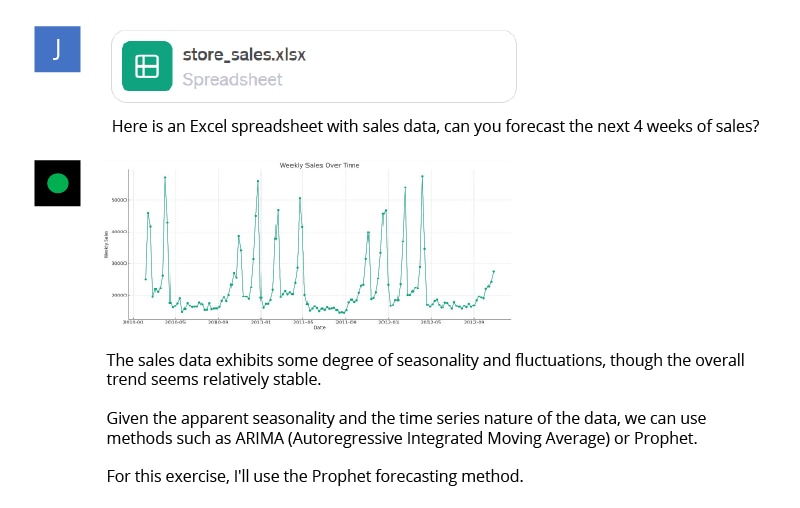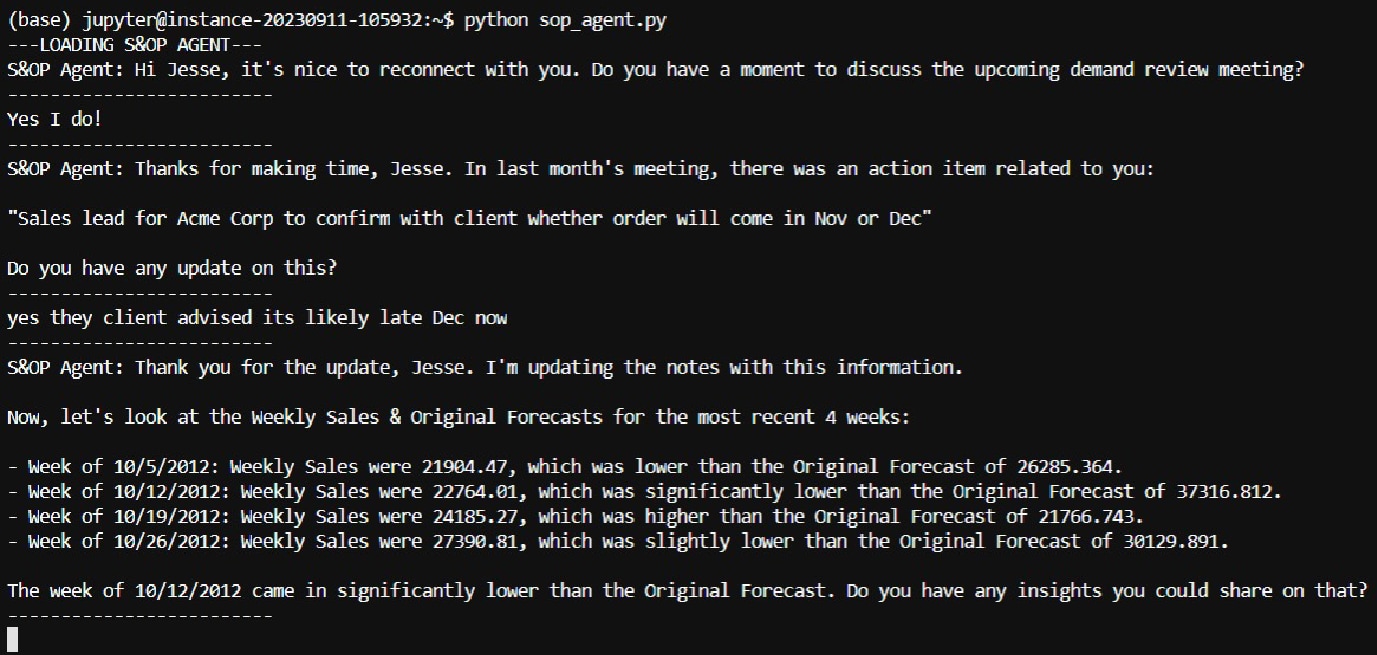AI: The Helping Hand in Sales and Operations Planning | Deloitte US has been saved
Artificial intelligence (AI) in sales and operations planning (S&OP)
In our previous blog post, The Human Touch, we explored common use cases for (AI) in supply chain planning today, discussing where it can best add value and where to apply more human intelligence.1 Given the buzz set off by popular Generative AI (GenAI) chat services, no discussion on AI would be complete without mentioning the large language models (LLMs) currently captivating the business landscape. This post explores the frontiers of how LLMs can and likely soon will be applied in the S&OP process of the future. We see three primary use cases, one of which is poised for near-term implementation by companies at a mature phase in their S&OP journey.

How AI is being applied today
Before exploring the future, let’s recap one of the primary ways AI and machine learning are used in supply chain planning today. Currently, many companies use models such as gradient boosted decision trees in combination with automated pipelines for training, testing, and prediction to generate demand forecasts. In our previous post, we described how this forecasting approach is well suited for near-term forecasts at the detailed item level, often referred to as sales and operations execution (S&OE). For longer-range planning at the aggregate category level, we suggest organizations apply more human intelligence. Reasons for this suggestion include that longer-range outcomes can be substantially impacted by the actions we take today, making human alignment on the plan a critical factor.
How LLMs can play a new role
The framework below treats LLMs as distinct from the forecasting models described above. Although recent research has shown complex prompts can allow LLMs to generate accurate forecasts, it seems unlikely that large enterprises would use anything other than dedicated forecasting models.2 This is due to the need for both accuracy and high-volume, low-cost forecasts. With this framework in mind, we see three primary use cases for LLMs in supply chain planning (one of which is poised for near-term implementation):
- Forecasting code gen: LLMs can help less technically proficient users interact with forecasting models. Although mainstream services currently do not excel at this task, fine-tuned models are likely on the horizon and may someday prove to be an excellent copilot for demand planners.

We recently performed tests on a publicly available GenAI chat service using different datasets. We found that it continually attempted to use one forecasting model that had been widely implemented but also criticized by forecasting experts and researchers.3 These tests underscored the tendency of mainstream services to repeat code frequently seen in its training data, but they were impressive nonetheless. You can view live demos with similar results online. - Structuring unstructured data: LLMs also hold the potential to turn unstructured text into numerical or categorical features that can be input into forecasting models. One GenAI chat services company currently has an example in which product reviews are converted to LLM embeddings and input into a model to predict review scores.4 It’s a small jump to envision how this approach could be used for forecasting. This is an exciting innovation, but we have yet to see it implemented at scale.
- Assisting the planning team: Perhaps the key innovation is in LLMs’ ability to assist the planning team—organizing and summarizing large amounts of structured and unstructured data. For example:
• What critical assumptions were discussed in last month’s demand review?
• What are the biggest changes to the forecasts since last month?
• What is the status of the new product launch scheduled for Q4?
Good planning is built on gathering, organizing, and disseminating key information to help achieve organizational alignment. However, many organizations struggle with the tactical logistics. We believe LLMs can become the helping hand. Critically, this use case is also poised for implementation, as it is built on a foundational LLM use case: LLM agents that can read from and write to internal company document stores.
The S&OP process of the future
Imagine a chatbot that contacts the sales lead for a major account seven days before the demand review meeting, every month, like clockwork. It follows up on action items, provides a summary of key takeaways from last month’s meeting, and highlights where recent sales numbers diverged most from the forecast. It then introduces new forecasts and solicits input, emphasizing areas to focus on based on previous discussions and results.

These interactions occur simultaneously with all stakeholders for the demand review. Their inputs are structured, organized, and filed. When multiple stakeholders raise a similar point, the LLM assistant highlights areas of consensus in its automatically generated preread that is sent to all participants before the meeting.
When the meeting takes place, the discussion is transcribed by AI, and this text is leveraged to create another set of key takeaways that are used to guide the prep work in the next cycle.
The path ahead
Driven by the latest innovations in large language models, task-specific chatbots are becoming a reality for supply chains, and can help optimize human inputs to planning. These chatbots can securely interface with internal data, providing unprecedented integrations. We've taken the initiative, experimenting with tools such as Langchain to prototype an "S&OP agent" that shows promising utility (screenshot above). Alongside our efforts, some of our colleagues are pioneering their own explorations with a generative AI supply chain planning assistant. As these tools evolve, it's conceivable they will become integral in reshaping how S&OP operates. Now is the moment to dive into this new frontier, learn, adapt, and be at the forefront of what’s next. Companies interested in exploring AI for S&OP can take the following steps:
- Assess the maturity of your S&OP process: An AI implementation may not be the next logical step for many companies . An initial capability-building program might unlock more lower-hanging value while setting the stage for a follow-on AI implementation.
- Seek partners with domain expertise: Building the S&OP agent solution described in this article doesn’t require a team of PhDs. However, it does require individuals with both knowledge of AI tools and a deep understanding of the business case. The key to implementation is adapting existing tools to fit your company’s specific business needs.
- Run a small-scale pilot: The plug-and-play nature of many of today’s tools allows for experimentation from day one. Try an eight- to 12-week pilot as a way to collect feedback from potential users and refine your approach with considerations such as target users, use cases, timing, and internal priorities. Insights from the pilot can be used to inform the development of an implementation road map.
Authors:
 |  |
Vinay Rajani | Preeti AryaCrossman |
Thank you to our contributors: Michael Mccafferty and Jesse Miller.
Endnotes:
1 Vinay Rajani and Preeti AryaCrossman, The human touch in sales & operations planning: Why it matters amid automation and AI in supply chain, Deloitte Business Operations Room Blog, August 3, 2023.
2 Gruver et al., “Large language models are zero-shot time series forecasters,” 37th Conference on Neural Information Processing Systems (NeurIPS 2023), 2023.
3 Pritam Bordoli, “Facebook Prophet falls out of favor,” Analytics India Magazine, June 24, 2022.
4 GitHub, “openai-cookbook classification using embeddings,” 2023.

